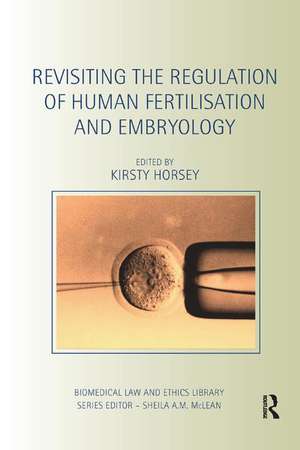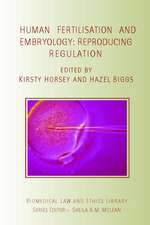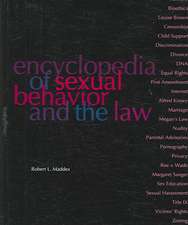Revisiting the Regulation of Human Fertilisation and Embryology: Biomedical Law and Ethics Library
Autor Kirsty Horseyen Limba Engleză Paperback – 7 feb 2017
This book critically considers recent developments in human fertilisation legislation, asking whether the 2008 Act has achieved its stated aim of being fit for purpose. Bringing together a range of international experts, the book evaluates the fresh risks and challenges emerging from both established and existing technologies and techniques in the field of human fertilisation and embryology, as well as offering valuable insights into the social and regulatory challenges that lie ahead. Key topics include problems with DIY assisted conception; the lack of reform in respect of the regulation of surrogacy arrangements; and mitochondrial DNA transfer.
As a review of the status of assisted reproduction legislation, this book will be of great use and interest to students, researchers and practitioners in medical law, bioethics, medicine and child welfare.
| Toate formatele și edițiile | Preț | Express |
|---|---|---|
| Paperback (1) | 464.54 lei 6-8 săpt. | |
| Taylor & Francis – 7 feb 2017 | 464.54 lei 6-8 săpt. | |
| Hardback (1) | 1055.51 lei 6-8 săpt. | |
| Taylor & Francis – 25 iun 2015 | 1055.51 lei 6-8 săpt. |
Din seria Biomedical Law and Ethics Library
-
 Preț: 295.14 lei
Preț: 295.14 lei -
 Preț: 325.93 lei
Preț: 325.93 lei -
 Preț: 311.70 lei
Preț: 311.70 lei -
 Preț: 317.35 lei
Preț: 317.35 lei -
 Preț: 430.00 lei
Preț: 430.00 lei - 18%
 Preț: 1055.84 lei
Preț: 1055.84 lei - 18%
 Preț: 999.97 lei
Preț: 999.97 lei -
 Preț: 322.97 lei
Preț: 322.97 lei - 18%
 Preț: 1272.79 lei
Preț: 1272.79 lei - 22%
 Preț: 324.16 lei
Preț: 324.16 lei - 18%
 Preț: 1001.00 lei
Preț: 1001.00 lei - 15%
 Preț: 444.36 lei
Preț: 444.36 lei - 18%
 Preț: 1114.98 lei
Preț: 1114.98 lei - 18%
 Preț: 1170.29 lei
Preț: 1170.29 lei -
 Preț: 471.33 lei
Preț: 471.33 lei - 18%
 Preț: 1056.00 lei
Preț: 1056.00 lei -
 Preț: 412.27 lei
Preț: 412.27 lei -
 Preț: 479.19 lei
Preț: 479.19 lei -
 Preț: 449.41 lei
Preț: 449.41 lei - 28%
 Preț: 823.44 lei
Preț: 823.44 lei -
 Preț: 416.22 lei
Preț: 416.22 lei - 18%
 Preț: 1059.48 lei
Preț: 1059.48 lei -
 Preț: 464.93 lei
Preț: 464.93 lei - 5%
 Preț: 440.43 lei
Preț: 440.43 lei -
 Preț: 319.81 lei
Preț: 319.81 lei -
 Preț: 451.97 lei
Preț: 451.97 lei - 22%
 Preț: 310.53 lei
Preț: 310.53 lei -
 Preț: 281.09 lei
Preț: 281.09 lei -
 Preț: 406.81 lei
Preț: 406.81 lei - 18%
 Preț: 1057.05 lei
Preț: 1057.05 lei - 26%
 Preț: 818.67 lei
Preț: 818.67 lei -
 Preț: 464.54 lei
Preț: 464.54 lei - 22%
 Preț: 341.61 lei
Preț: 341.61 lei - 18%
 Preț: 1000.27 lei
Preț: 1000.27 lei - 30%
 Preț: 852.35 lei
Preț: 852.35 lei -
 Preț: 467.44 lei
Preț: 467.44 lei - 5%
 Preț: 1159.05 lei
Preț: 1159.05 lei
Preț: 464.54 lei
Nou
Puncte Express: 697
Preț estimativ în valută:
88.89€ • 93.07$ • 73.73£
88.89€ • 93.07$ • 73.73£
Carte tipărită la comandă
Livrare economică 09-23 aprilie
Preluare comenzi: 021 569.72.76
Specificații
ISBN-13: 9781138713055
ISBN-10: 1138713058
Pagini: 256
Ilustrații: 3 Tables, black and white
Dimensiuni: 156 x 234 x 13 mm
Greutate: 0.34 kg
Ediția:1
Editura: Taylor & Francis
Colecția Routledge
Seria Biomedical Law and Ethics Library
Locul publicării:Oxford, United Kingdom
ISBN-10: 1138713058
Pagini: 256
Ilustrații: 3 Tables, black and white
Dimensiuni: 156 x 234 x 13 mm
Greutate: 0.34 kg
Ediția:1
Editura: Taylor & Francis
Colecția Routledge
Seria Biomedical Law and Ethics Library
Locul publicării:Oxford, United Kingdom
Public țintă
PostgraduateCuprins
1. Revisiting the Regulation of Human Fertilisation and Embryology, Kirsty Horsey 2. From need "for a father" to need "for supportive parenting": changing conceptualisations of the welfare of the child following assisted reproductive technology in the United Kingdom, Eric Blyth 2. The Law and DIY Assisted Conception, Emily Jackson 3. Prisoners’ Access to Fertility Services, Helen Codd 4. Thinking outside the (egg) box: Egg-share agreements, cord blood and ‘benefits-in-kind’, Karen Devine 5. PGD Past, Present and Future: Is the HFE Act ‘Fit for Purpose’? , Jeanne Snelling and Colin Gavaghan 6. The ‘Two-mother’ Misnomer: Mitochondrial DNA Transfer Under the HFE Act, Laura Riley 7. The Fertility Treatment Time Forgot: What Should be Done About Surrogacy in the UK?, Kirsty Horsey and Katia Neofytou 8. Access to Genetic and Biographical History in Donor Conception: An Analysis of Recent Trends and Future Possibilities, Eric Blyth and Lucy Frith 9. Compensating reproductive harms in the regulation of 21st century assisted conception, Antony Blackburn-Starza 10. ‘A less than perfect law’: The unfulfilled promise of Canada’s Assisted Human Reproduction Act, Pamela White 11. The regulation of PGD for medical sex selection and the gendering of disability in the UK and Australia, Isabel Karpin 12. New wine in old bottles and old wine in new bottles: The judicial response to international commercial surrogacy in the United Kingdom and Australia, Anita Stuhmcke
Descriere
The Human Fertilisation and Embryology Act 2008 was a major update to the UK’s laws on the use reproductive technology and regulation of assisted reproduction. This book critically evaluates the recent developments, asking whether the Act has achieved the stated aim of being ‘fit for purpose’ or, if not, what should be done to improve it. It brings together a range of experts in law and ethics in order to evaluate the fresh risks and challenges emerging from both established and existing technologies and techniques in the field of human fertilisation and embryology, as well as offering valuable insights into the social and regulatory challenges that lie ahead.










